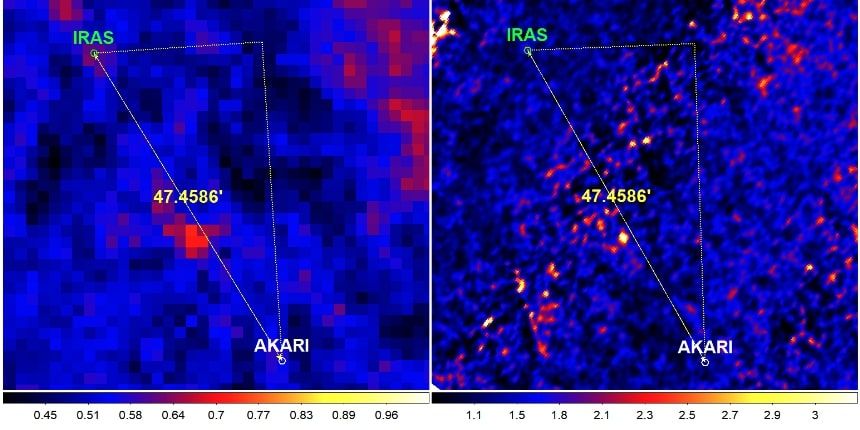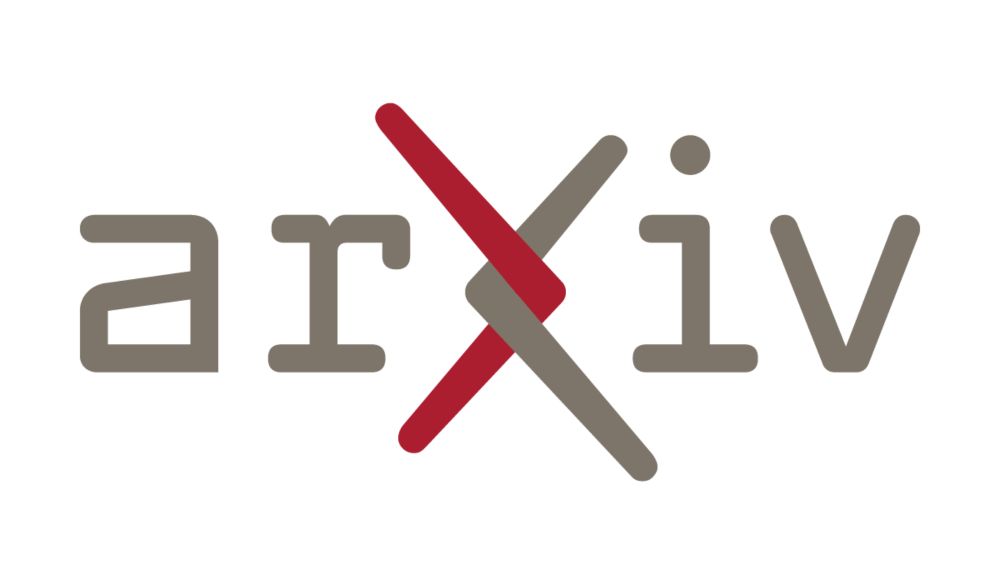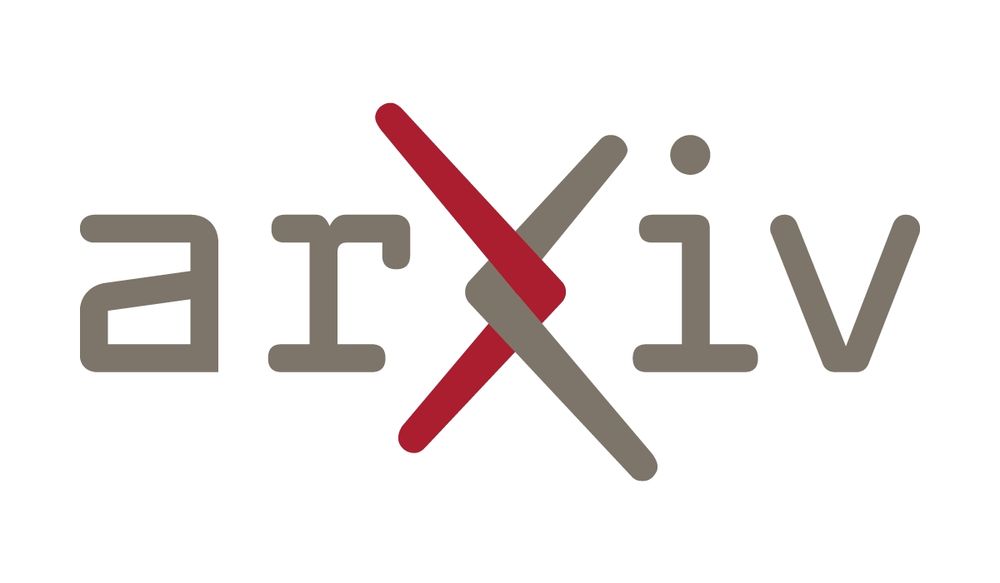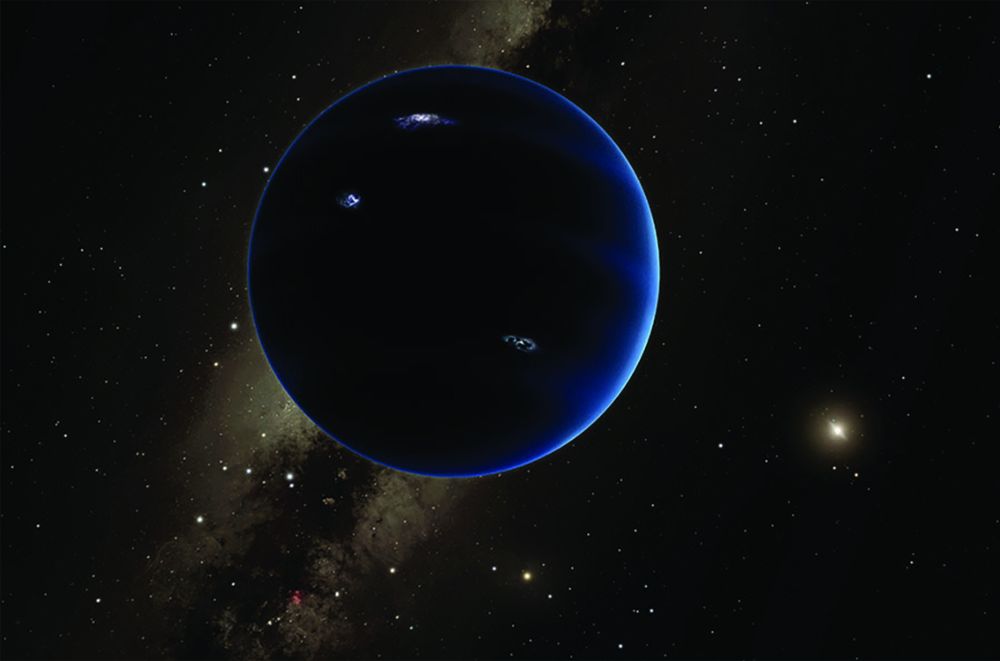
Planet Nine Candidate from IRAS and AKARI Data
Researchers for objects that moved slowly between IRAS and AKARI detections. IRAS and AKARI are far-infrared, all-sky surveys completed 23 years apart. They looked in the Kuiper belt.
They produced all possible candidate pairs including one IRAS source and one AKARI source whose angular separations were limited between 42′ and 69.6′, corresponding to the heliocentric distance range of 500 – 700 AU and the mass range of 7– 17M⊕. There were 13 candidate pairs obtained after the selection criteria. After image inspection, they **found one good candidate** , of which the IRAS source is absent from the same coordinate in the AKARI image after 23 years and vice versa. However, AKARI and IRAS detections are not enough to determine the full orbit of this candidate.
9 detections are required to evaluate a linked Keplerian orbit with improved processing speed and reduce the number of false positives.
They will need the new and better space telescopes to re-examine the candidate to see if they can confirm that is planet 9 or not.
The IRAS and AKARI detections alone are not enough to decide a precise orbit. The DECam, with a large field of view, is a prospective option for the follow-up observation. It enables the possibility of detecting faint moving objects even in optical wavelengths and determining the full orbit of
our candidate, since the exposure time to observe targets as faint as 26 AB mag at DECam is approximately one hour. The verification of Planet Nine’s existence via future observational studies will contribute to our understanding of the evolution and structural dynamics of the solar system.
Brian Wang
Brian Wang is a Futurist Thought Leader and a popular Science blogger with 1 million readers per month. His blog Nextbigfuture.com is ranked #1 Science News Blog. It covers many disruptive technology and trends including Space, Robotics, Artificial Intelligence, Medicine, Anti-aging Biotechnology, and Nanotechnology.
Known for identifying cutting edge technologies, he is currently a Co-Founder of a startup and fundraiser for high potential early-stage companies. He is the Head of Research for Allocations for deep technology investments and an Angel Investor at Space Angels.
A frequent speaker at corporations, he has been a TEDx speaker, a Singularity University speaker and guest at numerous interviews for radio and podcasts. He is open to public speaking and advising engagements.
Planet Nine Candidate from IRAS and AKARI Data Researchers for objects that moved slowly between ...
https://www.nextbigfuture.com/2025/05/planet-nine-candidate-from-iras-and-akari-data.html
#Science #Space #Technology #astronomy #science #space #technology
Result Details
03.05.2025 07:43 — 👍 1 🔁 1 💬 0 📌 0
A far-infrared search for planet nine using AKARI all-sky survey | Publications of the Astronomical Society of Australia | Cambridge Core
A far-infrared search for planet nine using AKARI all-sky survey - Volume 42
Check out this popular article in #PASA Chen, Goto, Yamamura, Nakagawa, Wu, Phan, Hashimoto, Uno, Ho, Kim: "A Far-Infrared Search for Planet Nine Using AKARI All-Sky Survey"
Read for free thanks to #OpenAccess
cup.org/44rkqbk
30.06.2025 13:50 — 👍 1 🔁 1 💬 0 📌 0
@astrominh.bsky.social I just wonder after submission, if the Editorial Board makes a decision that the paper is not eligible for publication in PASA Letter, do authors have to manually submit their paper again to the usual PASA?
27.06.2025 13:07 — 👍 0 🔁 0 💬 0 📌 0
The PASA Editorial Board and I are proud to announce PASA is now accepting Letter submissions!
21.05.2025 09:25 — 👍 8 🔁 2 💬 1 📌 0
@plutokiller.com I'm just wonder if it's possible that the orbital clustering of minor KBOs is driven by the gravity of two planets? Have you ever simulated this scenario?
03.05.2025 08:29 — 👍 0 🔁 0 💬 2 📌 0
@plutokiller.com Although we haven't estimated it yet in this work, I would say that all IRAS and AKARI sources before pairing up were required to have high flux quality (fqual value) at 60, 65, 90, and 100 micron. By this way we can remove unreliable sources from the beginning.
03.05.2025 08:23 — 👍 0 🔁 0 💬 0 📌 0
@mbmocam.bsky.social Using Machine Learning to speed up the data analysis is a good idea. We'll consider applying it to our next studies.
03.05.2025 08:13 — 👍 3 🔁 0 💬 0 📌 0
@mbmocam.bsky.social JWST can be used for deeper researches on P9 unless we know where it is on its orbit. Due to the uncertainty of P9's heliocentric distance, I think it's currently better to search by using all-sky surveys with larger field of view.
03.05.2025 08:10 — 👍 1 🔁 0 💬 0 📌 0
@astrafoxen.bsky.social
Anyway, thank you for raising an important point. It is worth checking and discussing in more detail in the follow-up studies.
01.05.2025 04:00 — 👍 6 🔁 0 💬 1 📌 0
@astrafoxen.bsky.social
However, the angular resolution of IRAS is 1.2’ at 60um. Within a radius of 1.2', there are even more sources that raise the difficulty in determining which source is the true counterpart of our IRAS source.
01.05.2025 04:00 — 👍 3 🔁 0 💬 0 📌 0
@astrafoxen.bsky.social
To be specific, in Section 6 of that paper, they classified objects based on the AKARI-IRC or AKARI-FIS detections, which are absent in the output result. Additionally, the WISE image shows nearby sources around the IRAS position.
01.05.2025 03:59 — 👍 3 🔁 0 💬 0 📌 0
@astrafoxen.bsky.social
The IRAS source in our candidate indeed matches with a WISE source when checking the IRAS-PSC/FSC Combined Catalogue (Abrahamyan et al. 2015). However, the classification method presented in that paper seems to be insufficient to conclude that our IRAS source is a galaxy.
01.05.2025 03:57 — 👍 3 🔁 0 💬 0 📌 0
Having meticulously identified this candidate from two million IRAS+AKARI objects, I believe it still merits immediate and thorough follow-up observations to determine its planetary status and orbital characteristics.
01.05.2025 03:55 — 👍 3 🔁 0 💬 1 📌 0
Thank you for a very important point. While our candidate is at a higher orbital inclination than predicted by your simulations, however, the detection of a giant planet would still be an interesting discovery regardless of its precise orbit.
01.05.2025 03:55 — 👍 1 🔁 0 💬 1 📌 0
Dear Prof. Brown, I’m Terry - the 1st author of the paper. Thank you for reading our paper! I started this research motivated by your paper and presentations. It is a great pleasure to have your comments on my paper.
01.05.2025 03:55 — 👍 10 🔁 0 💬 1 📌 0
https://arxiv.org/abs/2504.17288
arXiv abstract link
A Search for Planet Nine with IRAS and AKARI Data
https://arxiv.org/pdf/2504.17288
Terry Long Phan, Tomotsugu Goto, Issei Yamamura, Takao Nakagawa, Amos Y.-A. Chen, Cossas K.-W. Wu, Tetsuya Hashimoto, Simon C.-C. Ho, Seong Jin Kim.
25.04.2025 07:29 — 👍 4 🔁 2 💬 2 📌 0

A Search for Planet Nine with IRAS and AKARI Data
The outer solar system is theoretically predicted to harbour an undiscovered planet, often referred to as P9. Simulations suggest that its gravitational influence could explain the unusual clustering ...
I have a couple of thoughts about the new paper the finds a candidate Planet Nine in some old data. First, it is difficult to tell how seriously to take this because a false alarm probability is never discussed, and second, if it is real, it is not Planet Nine. Read on:
🧵🔭🧪
arxiv.org/abs/2504.17288
26.04.2025 20:43 — 👍 145 🔁 30 💬 17 📌 3
Unofficial bot by @vele.bsky.social w/ http://github.com/so-okada/bXiv https://arxiv.org/list/astro-ph.EP/new
List https://bsky.app/profile/vele.bsky.social/lists/3lim7ccweqo2j
ModList https://bsky.app/profile/vele.bsky.social/lists/3lim3qnexsw2g
Unofficial bot by @vele.bsky.social w/ http://github.com/so-okada/bXiv https://arxiv.org/list/astro-ph.IM/new
List https://bsky.app/profile/vele.bsky.social/lists/3lim7ccweqo2j
ModList https://bsky.app/profile/vele.bsky.social/lists/3lim3qnexsw2g
Unofficial bot by @vele.bsky.social w/ http://github.com/so-okada/bXiv https://arxiv.org/list/astro-ph.SR/new
List https://bsky.app/profile/vele.bsky.social/lists/3lim7ccweqo2j
ModList https://bsky.app/profile/vele.bsky.social/lists/3lim3qnexsw2g
New submissions in arXiv
Category: Astrophysics
https://arxiv.org/list/astro-ph/new
Administrator: krypf @krypf.bsky.social
lit link: lit.link/krypf
The latest news in Physics, Computer Science, Engineering, Astronomy and Astrophysics from @cambridgeup.bsky.social
Our publications, research, and higher education solutions spread knowledge, spark curiosity and aid understanding around the world.
View our social media commenting policy here: https://cup.org/38e0Gv2
The European Southern Observatory designs, builds & operates world-class observatories on the ground for the benefit of society. More info on eso.org
Radio astronomer. Politics nerd. Avid ultimate frisbee player. Comic book geek and MCU fan. Opinions own. she/her, dr 🏳️🌈
We are The Event Horizon Telescope who captured the first image of a black hole with a virtual Earth-sized telescope.
Instagram, Twitter, Facebook: ehtelescope
eventhorizontelescope.org
A Nature journal dedicated to presenting the very best research across the disciplines of astronomy, astrophysics, cosmology and planetary science.📡
www.nature.com/natastron
Official account for Publications of the Astronomical Society of Australia (PASA). We are a leading open access journal which publishes new and significant peer-reviewed research in astronomy and astrophysics. https://tinyurl.com/4n9324mj
NASA science writer, freelance environmental writer, mom of three 💙💙🩷
20 - any pronouns
Astrophysics undergrad student in California (grad '27), aspiring planetary scientist. I do astronomy research on asteroids, comets and TNOs!
pfp by EchaSkqech
banner by Ian Regan
Keeping you posted on space science activities from the European Space Agency.
Web: http://www.esa.int/science
Privacy Notice: esa.int/connectwithus
#astronomy #space #science
Excellent Research in Astronomy and Astrophysics across wavelengths from (sub-)millimeter and infared all the way to X-ray and gamma-ray. Posts by Press Office.
https://www.mpe.mpg.de/impressum
Astronomical research institute in Heidelberg, Germany / Astronomisches Forschungsinstitut in Heidelberg
Impressum: https://www.mpia.de/impressum
Digestible summaries of the latest astronomy research. Written by an international team of grad students for undergrads! Supported by the @AAS_Office. #scicomm
The mission of the American Astronomical Society is to enhance and share humanity’s scientific understanding of the universe as a diverse and inclusive astronomical community.
aas.org




